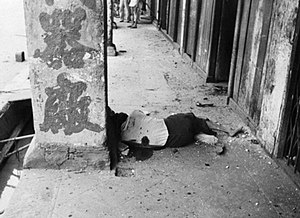Bombing of Singapore (1941)
| Bombing of Singapore | |||||||
|---|---|---|---|---|---|---|---|
| Part of the Malayan Campaign, Pacific War | |||||||
 A dead civilian lying on the floor of a five-foot way along South Bridge Road, victim of the Japanese air attack on Singapore. |
|||||||
|
|||||||
| Belligerents | |||||||
|
Dalforce |
|||||||
| Units involved | |||||||
| Malaya Command | Mihoro Air Group | ||||||
| Strength | |||||||
| Various number of anti-aircraft guns 1 battleship 1 battlecruiser |
17 aircraft | ||||||
| Casualties and losses | |||||||
| 61 killed 700 wounded |
N/A | ||||||
The bombing of Singapore was an attack on 8 December 1941 by seventeen G3M Nell bombers of Mihoro Air Group (Mihoro Kaigun Kōkūtai),Imperial Japanese Navy, flying from Thu Dau Mot in southern Indochina. The attack began at around 0430, shortly after Japanese forces landed on Kota Bharu, Malaya. It was the first knowledge the Singapore population had that war had broken out in the Far East.
The attack on Singapore was assigned to 34 bombers of Genzan Air Group (Genzan Kaigun Kōkūtai) and 31 bombers of Mihoro Air Group. Their targets were RAF Tengah, RAF Seletar, Sembawang Naval Base and Keppel Harbour.
Six squadrons from both air groups took off from southern Indochina on the night of 7 December 1941. However, bad weather conditions were encountered while over the South China Sea. Thick clouds offered poor visibility for the pilots, while rough winds caused most of the formations to become separated. After several attempts to regroup failed, Lieutenant Commander Niichi Nakanishi, Wing Commander of Genzan Air Group, ordered them to abort mission and return to base, thereby reducing the impact of a much heavier raid. Only seventeen G3M bombers of Mihoro Air Group reached Singapore on schedule, unobstructed by bad weather.
...
Wikipedia
